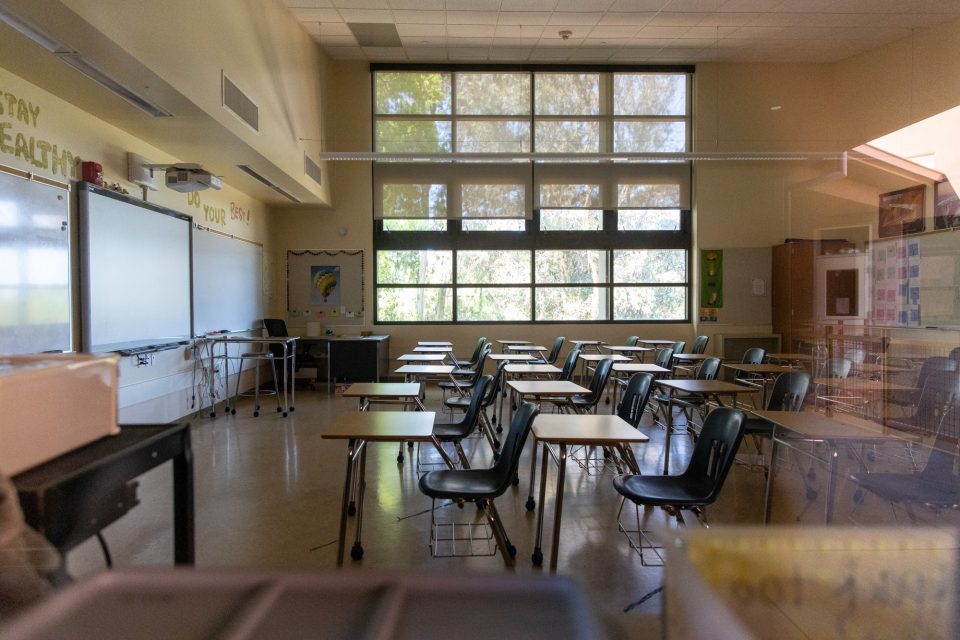After two months of negotiations, the Palo Alto Unified teachers union is urging the district against reopening schools this fall and instead is asking for a return to full distance learning.
In an open letter to the school board and top district leaders, the union cited a list of concerns about the logistics, risks and limitations of in-person instruction, as well as the local spike in coronavirus cases. Santa Clara County reported 192 new cases of the COVID-19 on Tuesday, bringing its total to 6,725.
“While we have been negotiating since May in good faith about how to structure a return to school, we have increasing concerns whether this can be done while maintaining the health and safety of our students and staff as this pandemic shows no signs of going away,” the union wrote. “As much as we love our students and miss teaching in person, it is not safe to return to the classroom at this time.”
The letter, which is dated July 13 but was posted to the district website on Wednesday, is signed by the Palo Alto Educators Association executive board and negotiations team and more than 400 district teachers. It comes on the heels of the announcement that California’s two largest school districts, Los Angeles Unified and San Diego Unified, will be online only this fall, and intensifying lobbying by the state teachers union to delay the reopening of schools.
The school district is currently planning to bring elementary school students and teachers back in person this fall but have middle and high schoolers learn primarily online, with some opportunities for small-group activities in person. Superintendent Don Austin said Wednesday that the reopening plan remains unchanged — any revisions would be subject to approval by the school board.
“A petition is not a board decision,” he said of the union’s letter. “At some point, the board will have to decide what they would like to do as far as our instructional delivery model for the fall.”
“If we’re holding out for a return across the state until classes look and feel normal,” he added, “that’s unrealistic.”
The Palo Alto Educators Association cited concerns about the “effectiveness” of social distancing, writing that “it is not realistic to expect that safe distances from one another would be able to be maintained” in classrooms, during passing periods and lunch and in restrooms.
The union argues that elementary-aged children, for whom the district has said in-person instruction is more critical, will not be able to adhere to social distancing.
“They will fight, cry and demand comfort, make messes, and need to be cleaned. How will these incidents look different in a school prepared for COVID-19? How will educators help from 6 feet away?” the union wrote.
One argument for reopening elementary schools — that young children are less likely to spread the coronavirus to each other — “leaves out the risk to the adults in the classroom that are being exposed, and the risk is much greater to them,” the union wrote.
Older students might also “knowingly disregard or defy rules regarding masks and social distancing,” the letter states. “We’ve already seen our students off campus this summer ignoring these guidelines, and would certainly see it continue when school resumes. PAUSD should be mindful of the near impossibility of having all members of the community follow necessary preventative measures.”
The letter also raises questions about how cleaning procedures, proper ventilation and hygiene practices will work on the ground in person.
The teachers union points to the many “obstacles” in the way of teachers doing their jobs successfully in a hybrid model, including workload and classroom dynamics. The union can’t imagine science courses without labs, physical education classes without group activities or drama lessons without close interaction between students — and conversely, a fruitful class discussion when everyone is wearing masks and seated far apart.
“There are so many pedagogical and logistical challenges, so many compromises on quality teaching and learning, that can be reduced or eliminated by choosing an online-only approach,” the letter reads. “While online instruction brings its own set of concerns and challenges, district time, energy, and resources would be much better spent on maximizing the quality of online instruction.”
(The union did acknowledge, however, that a hybrid model is a “viable option” when public health conditions improve.)
The teachers pressed the district to invest in online-learning training for teachers and to communicate clear expectations about the frequency, duration and method of distance learning for both teachers and families.
Austin said that he and other superintendents continue to struggle with a lack of guidance from public health and education leaders on what metrics they should consider in keeping schools open or closed. He asked the same question of the teachers who oppose returning to school in the fall.
“If it’s unsafe to come back now, what conditions have to come back in place to be safe enough to come back? I think that’s a question they need to answer,” he said.
Palo Alto Unified will continue negotiations with the union, Austin said. In case teachers are not on campuses this fall, the district is planning to have volunteers and administrators — including the superintendent himself — run PAUSD+, an in-person support program for struggling and at-risk students.
He continues to firmly believe that “in-person instruction for all students is crucial.”
According to a press release, in a virtual news briefing on Wednesday state Superintendent of Instruction Tony Thurmond “encouraged schools to continue designing plans for in-person instruction this fall but urged educators to prepare for the possibility of resuming distance learning based on current health and safety conditions.”
Thurmond said during the call: “There is no playbook for the times we’re in.”
Find comprehensive coverage on the Midpeninsula’s response to the new coronavirus by Palo Alto Online, the Mountain View Voice and the Almanac here.


